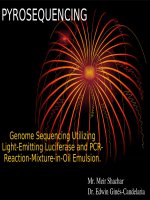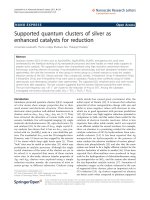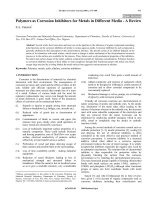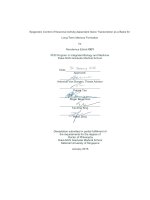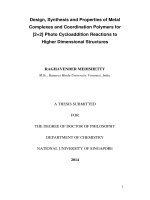Ruthenium carbonyl complexes as homogeneous catalysts for x h activation (x = c, n, o, si
Bạn đang xem bản rút gọn của tài liệu. Xem và tải ngay bản đầy đủ của tài liệu tại đây (2.77 MB, 208 trang )
RUTHENIUM CARBONYL COMPLEXES AS
HOMOGENEOUS CATALYSTS FOR X-H ACTIVATION
(X = C, N, O, Si)
TAN SZE TAT
NATIONAL UNIVERSITY OF SINGAPORE
2012
RUTHENIUM CARBONYL COMPLEXES AS
HOMOGENEOUS CATALYSTS FOR X-H ACTIVATION
(X = C, N, O, Si)
TAN SZE TAT
(B.Sc. (HONS), NUS)
A THESIS SUBMITTED
FOR THE DEGREE OF DOCTOR OF PHILOSOPHY
DEPARTMENT OF CHEMISTRY
NATIONAL UNIVERSITY OF SINGAPORE
2012
i
Acknowledgement
First and foremost, I am thankful to my supervisor and mentor, Assoc. Prof.
Fan Wai Yip, whose dedication and guidance from the initial to the final stages
enabled me to develop an understanding of the subject. I am grateful for the
constant encouragements and advices that he has given me through the years.
The research experience would not have been as enjoyable and fulfilling
without my fellow group members; Kee Jun Wei, Toh Chun Keong, Tan Kheng
Yee Desmond, Chong Yuan Yi, Fong Wai Kit, Chong Che Chang, Teng Guan Foo,
Sum Yin Ngai, Soh Wei Quan Daniel, Quek Linken, Lim Xiao Zhi, Tan Yong Yao,
Goh Wei Bin and Yang Jiexiang. It is an honour to be able to work with them, and
I sincerely thank them for their help and support all these years.
I also appreciate the support from Mdm Han Yanhui from the Chemistry
Department NMR Laboratory and Mdm Adeline Chia and Mdm Patricia Tan from
the Physical Chemistry Laboratory. I would also like to extend my gratitude to the
various Staff of the Chemistry Department who have help me in one way or
another.
I would like to acknowledge the encouragement that my family and wife
has given me. Their unconditional support has allowed me to persevere through the
course of study.
Lastly, I wish to thank the National University of Singapore for awarding
me a research scholarship and granting me the opportunity to pursue my degree.
ii
Thesis Declaration
The work in this thesis is the original work of Tan Sze Tat, performed
independently under the supervision of A/P Fan Wai Yip, (in the IR and Laser
Research Laboratory), Chemistry Department, National University of Singapore,
between 6 August 2007 and 6 January 2012.
The content of the thesis has been partly published in:
1) “Ligand-Controlled Regio- and Stereoselective Addition of Carboxylic
Acids Onto Terminal Alkynes Catalyzed by Carbonylruthenium(0)
Complexes” Eur. J. Inorg. Chem. (2010) 4631 – 4635).
2) “Catalytic Hydrogen Generation from the Hydrolysis of Silanes by
Ruthenium Complexes” Organometallics (2011) 30, 4008 – 4013.
3) “Addition of Pyrroles onto Terminal Alkynes Catalyzed by a Dinuclear
Ruthenium (II) Complex J. Organomet. Chem. (2012), 708 – 709, 58 – 64.
Tan Sze Tat 24 June 2012
Name Signature Date
iii
Table of Contents
Acknowledgement i
Table of Contents iii
Summary vii
List of Tables ix
List of Figures xi
List of Schemes xiii
CHAPTER 1 Introduction 1
1.1Organometallic Compounds in Catalysis 2
1.2 Ruthenium Carbonyl Complexes as Catalysts 6
1.2.1 Mononuclear Ruthenium (0) Complexes 10
1.2.2 Halogencarbonyl Ruthenium Complexes 15
1.3 Ruthenium-catalyzed Processes 17
1.3.1 Ruthenium-catalyzed Nucleophilic Addition across
Alkynes
17
1.3.2 Catalytic Silane Hydrolysis and Its Applications 20
1.4 Objectives 24
1.5 References 26
iv
CHAPTER 2 Ligand-Controlled Regio- and
Stereoselective Hydrocarboxylation onto Terminal
Alkynes Catalyzed by Ruthenium (O) Carbonyl
Complexes
35
2.1 Introduction 36
2.2 Experimental Section 38
2.2.1 General Procedures 38
2.2.2 Synthesis of Ru
3
(CO)
9
(PPh
3
)
3
38
2.2.3 Synthesis of Ru(CO)
3
(
4
-diene)
39
2.2.4 Synthesis of Ru(CO)
3
[P(OEt)
3
]
2
40
2.2.5 Synthesis of Ru(CO)
4
(PPh
3
)
41
2.2.6 Synthesis of Ru(CO)
3
(PPh
3
)
2
42
2.2.7 Synthesis of Ru(CO)
3
(PCy
3
)
2
42
2.2.8 Typical Procedure for Catalytic Reaction 43
2.3 Results and Discussion 47
2.4 Conclusion 57
2.5 References 58
CHAPTER 3 Addition of Pyrroles onto Terminal Alkynes
Catalyzed by Dinuclear Ruthenium (II) Complexes
63
v
3.1 Introduction 64
3.2 Experimental Section 66
3.2.1 General Procedures 66
3.2.2 Synthesis of Ru
2
(CO)
4
(PPh
3
)
2
Br
4
66
3.2.3 Synthesis of Ru
2
(CO)
6
Br
4
67
3.2.4 Synthesis for [Ru
2
(CO)
4
(CH
3
COO)
2
]
n
68
3.2.5 Typical Procedure for Catalytic Reaction 68
3.3 Results and Discussion 72
3.4 Conclusion 90
3.5 References 91
CHAPTER 4 Hydroamination onto Terminal Alkynes
Catalyzed by Dinuclear Ruthenium (II) Complexes
97
4.1 Introduction 98
4.2 Experimental Section 101
4.2.1 General Procedures 101
4.2.2 Ru
2
(CO)
2
L
2
X
4
complexes 101
4.2.3 Ru
2
(CO)
4
(CX
3
COO)
2
L
2
complexes 102
4.2.4 Typical Procedure for Catalytic Reaction 104
vi
4.3 Results and Discussion 108
4.4 Conclusion 122
4.5 References 123
CHAPTER 5 Catalytic Hydrogen Generation from
Hydrolysis of Silanes by Ruthenium Complexes
127
5.1 Introduction 128
5.2 Experimental Section 130
5.2.1 General Procedures 130
5.2.4 Typical Procedure for Catalytic Reaction 131
5.3 Results and Discussion 131
5.4 Conclusion 144
5.5 References 145
Appendix
150
vii
Summary
Ruthenium carbonyl complexes-catalyzed activation of unreactive
X-H bonds (X = C, N, O and Si) provides an elegant route for the
transformation of simple reactants to useful chemicals, and such processes
were explored in this thesis. In Chapter 1, a brief introduction to the
chemistry of transition metal carbonyls and the objectives of the work were
presented. The ability of transition metals to possess a wide variety of
oxidation states and coordination numbers; the use of carbonyl ligands to
facilitate mechanistic studies; and the use of various ligands to control the
steric and electronic properties of the metal complex in order to achieve
high selectivity and high product yields have been considered for the two
types of Ru-catalyzed reactions studied: (1) Nucleophilic addition across
alkynes, and (2) Silane hydrolysis.
In Chapter 2, the addition of carboxylic acids onto terminal alkynes
catalyzed by mononuclear ruthenium (0) complexes was studied. As
product selectivity is a major problem in hydrocarboxylation, finding a
catalytic system which can selectively produce only one isomeric product
is desirable. A variety of Ru(CO)
3
L
2
(where L is a 2 e
-
donor) complexes
was synthesized. Using ligands of different donor strengths, a direct
relationship between regioselectivity of the product and the electronic
property of the metal centre was observed.
The addition of pyrroles onto terminal alkynes catalyzed by
dinuclear ruthenium complexes was studied in Chapter 3. We proposed
viii
that the difficulties encountered in producing functionalized pyrroles can
be overcome via the formation of vinylpyrroles. The usefulness of this
system was thus illustrated by the formation of various dipyrrolmethanes,
achieved via further pyrrole addition onto vinylpyrroles. In addition, 2,5-
bis(vinyl)-pyrroles can also be prepared using this method.
In Chapter 4, the addition of N-methylaniline onto phenylacetylene
was studied using two types of dimeric ruthenium catalysts which were
Ru
2
(CO)
4
L
2
Br
4
and Ru
2
(CO)
4
(-CX
3
COO)
2
L
2
. The latter complexes were
found to be more catalytically active towards hydroamination, possibly due
to the more electron-rich metal centre which allows favourable activation
of substrates. Deuteration studies suggested that other pathways could
coexist with earlier mechanisms.
Silane hydrolysis and alcoholysis are important processes in
organic syntheses as it offers an alternate procedure for protecting
functional groups. In Chapter 5, we used Ru
2
(CO)
4
L
2
Br
4
to obtain very
high turnover numbers for the processes under mild conditions. The large
amount of hydrogen gas generated from the system provides a possible
alternative to existing hydrogen storage technology.
ix
List of Tables
Table 1.1 Elementary organometallic reaction steps 3
Table 1.2 Useful ruthenium complexes derived from Ru
3
(CO)
12
7
Table 1.3 Local M(CO)
x
symmetry consistent with the
observed number of IR-active (CO) absorptions
9
Table 2.1 Peaks observed in the
1
H NMR spectra of ruthenium
complexes 4 and 5.
40
Table 2.2
1
H NMR of various enol esters formed 44
Table 2.3 Peaks observed in the IR spectra of the ruthenium
complexes 1 – 9.
48
Table 2.4 Addition of carboxylic acids onto phenylacetylene
catalyzed by complexes 1 – 9.
49
Table 2.5 Addition of carboxylic acids onto 1-Heptyne
catalyzed by complexes 1 – 5 and 8.
54
Table 2.6 Product details for the addition of carboxylic acids
onto cyclohexylacetylene catalyzed by complex 5.
55
Table 3.1
1
H NMR of various pyrrole addition products
formed.
70
x
Table 3.2 Ruthenium-catalyzed hydroarylation of N-
methylpyrrole, 1a, with 2a.
76
Table 3.3 Catalytic reaction of 1a and 2a carried out in
different solvents
78
Table 3.4 Ru
2
(CO)
4
(PPh
3
)
2
Br
4
-catalyzed hydroarylation of
pyrroles, 1, with alkynes, 2
79
Table 4.1 Addition of methylaniline onto phenylacetylene
catalyzed by complexes 1 – 7.
106
Table 4.2 IR values of complexes 1 – 7. 107
Table 4.3 Deuteration studies of complex 3- catalyzed
hydroamination process.
120
Table 5.1 IR values of complexes 1-3 in chloroform.
132
Table 5.2 Product details for the hydrolysis of triethylsilane
catalyzed by some ruthenium complexes
133
Table 5.3 Product details for the hydrolysis of silanes catalyzed
by complex 1
135
xi
List of Figures
Figure 1.1
Empty P-R * orbital plays the role of acceptor in the
metal complexes of PR
3
, allowing -backbonding to
occur.
12
Figure 1.2 Bonding picture of metal-alkene complexes. 14
Figure 1.3 Molecular structure of [Ru(CO)
3
Br
2
]
2
. 16
Figure 3.1 (a) ORTEP view of solid-state structures of
Ru
2
(CO)
4
(PPh
3
)
2
Br
4
isomer A.
(b) ORTEP view of solid-state structures of
Ru
2
(CO)
4
(PPh
3
)
2
Br
4
isomer B.
73
Figure 3.2 Alkenyl region in the
1
H NMR spectrum showing the
formation of deuterated 2-vinylpyrroles.
84
Figure 3.3 FTIR spectrum obtained upon completion of the
catalysis.
85
Figure 4.1
1
H NMR spectrum of the hydroamination product. 105
Figure 4.2 IR spectra obtained (a) after catalysis; (b) from the
stoichiometric reaction of phenylacetylene with
Ru
3
(CO)
12
.
109
xii
Figure 4.3 ORTEP view of solid-state structures of complex 6. 110
Figure 4.4 ORTEP view of solid-state structures of complex 7. 111
Figure 4.5 IR spectrum of the reaction of 2 with N-
methylaniline in CHCl
3
.
114
Figure 4.6 The isotopic shift effect allow the quantification of
product C and D from the
1
H NMR spectrum.
118
Figure 5.1
1
H NMR spectrum obtained after the reaction of
complex 1-catalyzed hydrolysis of triethylsilane.
136
Figure 5.2 (a) FTIR spectrum obtained from the reaction of
complex 1-catalyzed hydrolysis of triethylsilane in
thf solvent.
(b)
1
H NMR spectrum of the reaction mixture
obtained after catalysis.
139
xiii
List of Schemes
Scheme 1.1 Catalytic Cycle for the E-Selective
Hydroamidation of 1-Hexyne and 2-Pyrrolidinone.
4
Scheme 1.2 CO dissociation of Ru(CO)
5
by ambient light,
resulting in the formation of clusters.
11
Scheme 1.3 Nucleophilic addition across alkynes give three
isomeric products (Geminal, Zusammen and
Entgegen)
18
Scheme 1.4 Ruthenium-catalyzed alkyne activation pathways
19
Scheme 1.5 Hydrolysis or alcoholysis of silanes catalyzed by
transition metal complexes.
20
Scheme 1.6 Proposed mechanism for iridium-catalyzed
alcoholysis of silanes
22
Scheme 2.1 The addition of carboxylic acids onto terminal
alkynes catalyzed by transition complexes yields
isomeric enol ester.
36
Scheme 2.2 Proposed reaction pathway of Mononuclear Ru(0)
complex-catalyzed hydrocarboxylation
52
Scheme 3.1 Markovnikov addition of pyrrole across a terminal
alkyne occur in the presence of a ruthenium
catalyst to produce vinylpyrrole.
64
xiv
Scheme 3.2 (A) 3c reacts immediately upon formation with
another molecule of pyrrole to give 4.
(B) Double addition involving 1a can only take
place using the less bulky Ru
2
(CO)
6
Br
4
catalyst.
(C) Addition of 1c to 3a can occur due to the lack
of steric bulk on the incoming pyrrole.
(D) Addition of 2a to 3a can occur when the
pyrrole-alkyne ratio is reduced.
(E) Similarly, addition of 2a to 3e can also occur.
81
Scheme 3.3 Reaction of 1a with d
1
-phenylacetylene. 83
Scheme 3.4 Proposed mechanism for the reaction of pyrroles
with alkynes.
89
Scheme 4.1 Ru
3
(CO)
12
forms a series of intermediates during
the catalysis.
99
Scheme 4.2 The addition product of aniline and
phenylacetylene can undergo isomerization to
form imines.
112
Scheme 4.3 Binding of substrates to the ruthenium centre. 117
Scheme 4.4 Deuteration studies using d-phenylacetyelene
produce a mixture of isotopomeric products.
118
Scheme 4.5 The hydroamination process catalyzed by complex
3.
121
xv
Scheme 5.1 Hydrolysis of silanes gives hydrogen and silanol. 128
Scheme 5.2 Proposed mechanism for the hydrolysis of silane
using complex 1 as the catalytic precursor.
141
Scheme 5.3 An alternate pathway involving charge separation
can also be considered for hydrogen production.
142
Chapter 1 Introduction
1
CHAPTER 1
Introduction
Chapter 1 Introduction
2
1.1 Organometallic Compounds in Catalysis
Organometallic compounds involve the direct interaction of a metal
and the carbon atom of an organic fragment. The study of such compounds
concerns the transformation of organic compounds using metals from the
main groups, transition series, lanthanides and actinides.
As organometallic compounds lie at the interface between classical
organic and inorganic chemistry, they often exhibit a combination of
properties that are unique, for instance, they possesses a blend of ionic and
covalent characters and can dissolve in organic solvents. Hence, since the
development of the first organo-transitionmetallic compound in the eighteenth
century [1], organometallic compounds have been developed for application
in catalysis and many other areas, including bioinorganic chemistry and
organic syntheses.
The unique properties of organometallic compounds allows these
compounds to exhibit catalytic behavior. Through the coordination of
substrates to a metal centre, the substrates are brought to within close
proximity of each other, which consequently increases the likelihood for a
reaction. The ability of transition metals to adopt a wide range of oxidation
state and coordination number further widens the application scope of
transition metal-organometallic compounds, especially in acid-base catalysis
[2], photocatalysis [3], homogeneous catalysis [4], heterogeneous catalysis [5]
and biphasic catalysis [6].
Chapter 1 Introduction
3
Table 1.1 Elementary organometallic reaction steps
Reaction
Change in
no. of
valence
electrons
Change in
oxidation
state
Change in
Coordination
coordination
number
Examples
Lewis acid ligand dissociation 0 0 -1
Lewis acid ligand association 0 0 +1
Lewis base ligand dissociation -2 0 -1
Lewis base ligand association +2 0 +1
Reductive elimination -2 -2 -2
Oxidative addition +2 +2 +2
Insertion -2 0 -1
Extrusion +2 0 +1
Oxidative coupling -2 +2 0
Reductive coupling +2 -2 0
Chapter 1 Introduction
4
Scheme 1.1 Catalytic Cycle for the E-Selective Hydroamidation of 1-Hexyne and 2-
Pyrrolidinone. L = PBu
3
or DMAP. Taken from reference [17].
Chapter 1 Introduction
5
In most cases, catalysis is facilitated by a series of elementary reaction
steps commonly associated with organometallic compounds (Table 1.1) [7]. A
combination of these steps will form a complete catalytic cycle, which is
exemplified by a recent work of Arndt et. al. on Ru-catalyzed hydroamidation
of terminal alkynes (Scheme 1.1) [8]. In their mechanism, ligand substitution
occurs via Lewis Base ligand association/ dissociation pathway in steps i and
ii to give the active catalytic species (I). Coordination of the substrate to the
16-electron species I then takes place via oxidative addition to give
intermediate II. In order for the catalysis to proceed, dissociation of a Lewis
base ligand must occur to generate a vacant site, which allows for substrate
coordination. Insertion of a proton to the alkyne would then give the vinylic
intermediate IV. Vinyl-vinylidene rearrangement then converts IV to V, such
that the amide inserts into the unsaturated bond to give VI. Through reductive
elimination of the ligands, the product is formed together with the
regeneration of I, thus completing the catalytic cycle. It is important to note
that there may be more than one mechanism dictating a catalytic system, and
it is a challenge to identify the most probable route through a combination of
spectroscopic and isotopic studies.
Modern chemistry requires the continuous discovery of new synthetic
methods that enables transformations with higher efficiencies and selectivities
(chemo-, regio-, diastereo and enantioselective). Finding new combinations of
substrates to produce high-value chemicals is also desirable. Due to cost and
environmental issues, the catalytic system needs to work well under mild
conditions, and give atom economy transformations whenever possible.
Chapter 1 Introduction
6
Among the different types of applications, homogeneous catalysis is widely
used and studied due to its enhanced efficiency and greater selectivity.
Although product isolation of the former complex from the reaction mixture is
challenging and could lead to economical and ecological problems, the
prospect of performing the reaction at low temperatures may outweigh the
disadvantages. More importantly, the mechanism of homogeneous catalytic
systems can be studied more easily using common spectroscopic techniques,
such as Mass Spectrometry, Nuclear Magnetic Resonance (NMR) or Fourier
Transformed Infra-Red (FTIR) spectroscopy. This methodology thus allows
for continual improvement in efficiency and selectivity of the system.
1.2 Ruthenium Carbonyl Complexes as Catalysts
From the list of many metals available for catalytic applications,
platinum group metals (Platinum, Palladium, Rhodium, Iridium, Ruthenium
and Osmium) possess outstanding catalytic properties. While they may have
similar chemical properties, the majority of catalytic transformations bearing
high chemo- and stereoselectivities have so far been contributed by palladium
or platinum catalysts [9]. Ruthenium complexes have been highlighted as
potent catalysts because the metal has the widest range of oxidation states and
coordination geometries of all elements in the periodic table [9-11]. In fact, a
variety of synthetic methods has already been reported using ruthenium
complexes in stoichiometric or catalytic amounts [11-18].
The transformation of raw ruthenium to useful catalysts usually takes
place via the hydrated RuCl
3
.nH
2
O complex [11]. The initial stage is the production of
Chapter 1 Introduction
7
Table 1.2 Useful ruthenium complexes derived from Ru
3
(CO)
12
Entry Reaction Ref
1
31
2
32
3
33
4
34
5
35
6
36
Chapter 1 Introduction
8
the ruthenium (III) salt, where chlorine gas was passed over ruthenium
powder at 700
0
C [19]. After RuCl
3
.H
2
O was formed, it can be converted to
the desired metal complex by reacting with a suitable reagent. One of the
complexes that is often made from RuCl
3
.H
2
O is the organometallic cluster
Ru
3
(CO)
12
, produced in high yields under high pressure of carbon monoxide
[20-21]. The trinuclear cluster in turn serves as a convenient precursor for the
syntheses of a variety of ruthenium carbonyl complexes, partly due to the fact
that the cluster complex is commercially available, and also eliminating the
need to deal further with high pressure carbon monoxide gas in later synthetic
steps [22-27] (Table 1.2). The reluctance to involve high pressure carbon
monoxide gas was due to the need for additional equipment, such as an
autoclave, which will increase the cost of synthesis [10, 28-29]. It is also
undesirable due to the potential risk of explosion and leakages, especially
when the highly toxic carbon monoxide is difficult to detect. Furthermore, the
ruthenium carbonyl cluster is relatively easy to handle as it is stable in
ambient environment.
Working with carbonyl compounds allow for easy characterization
using infrared spectroscopy as the carbonyl stretching frequencies, (CO), of
transition metals carbonyls generally occur in a region that is relatively free of
interference from most organic solvents (1750 – 2125 cm
-1
). Most of the time,
the IR spectra can shed light on the bonding mode, geometry and symmetry of
the metal carbonyl complexes [30], as well as offering a clue on the electronic
effects of any co-ligands [31-35]. A useful guide relating point group and vibrational

